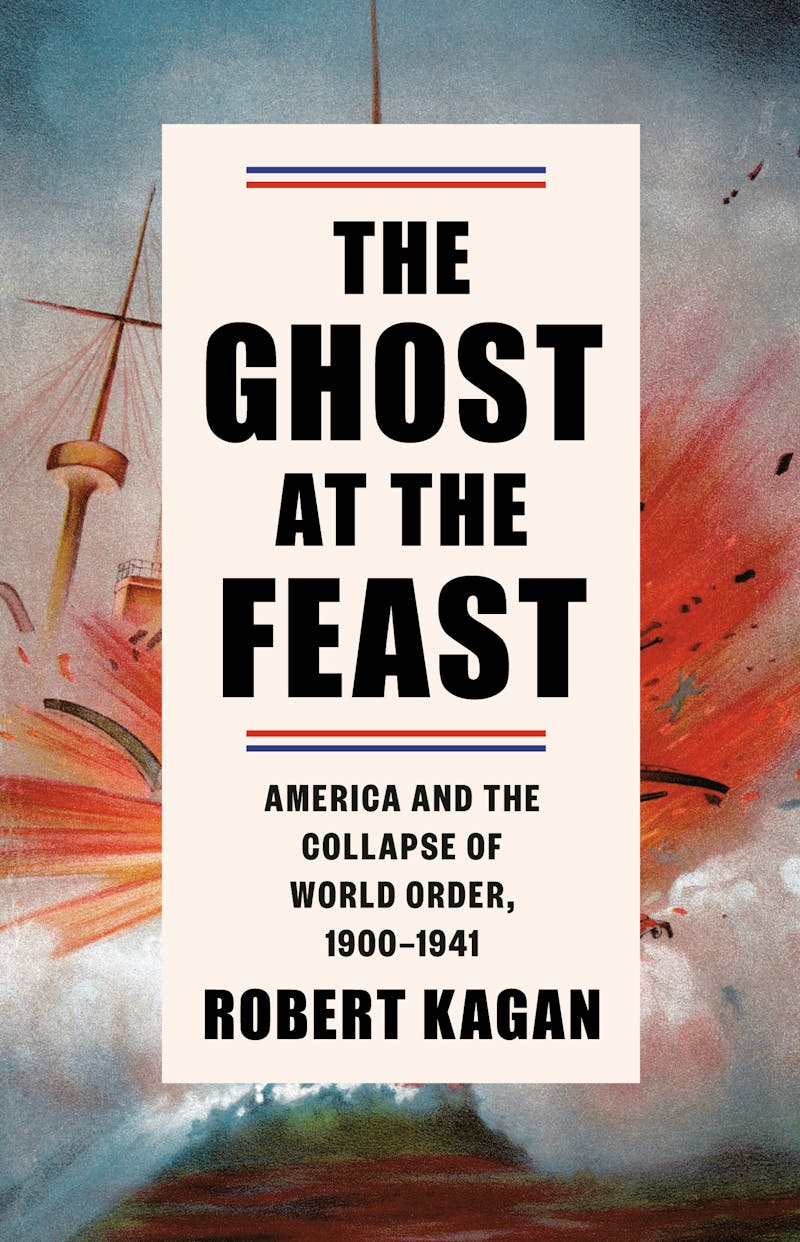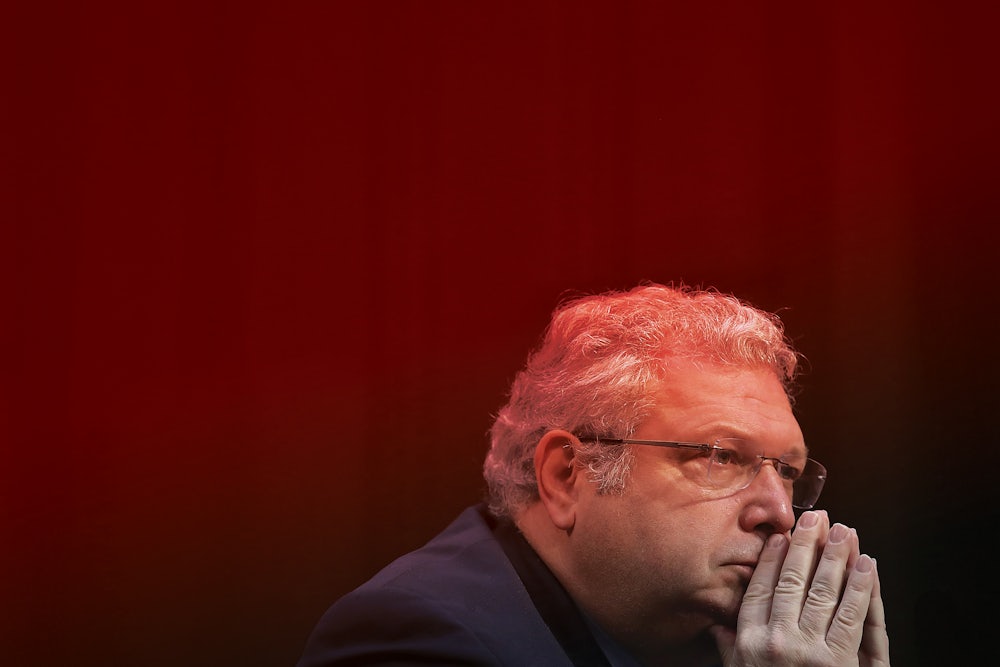From the days of his earliest foreign policy salvos, launched from the neoconservative mothership Commentary in the 1980s, Robert Kagan has held two core beliefs. First, though it is rare in human affairs, and threatened on all sides, freedom is possible in a fallen world. Second, only the United States can provide that freedom by superintending the international system, and resorting when necessary—distressingly often, it turns out—to armed might. One principle is pleasingly universal, if melodramatic and selective about how much freedom its defenders have achieved and what the most serious threats to that freedom are. But the other principle, which Kagan presents as a necessary corollary, routinely corrupts the first with its aggrandizing nationalism and violent warmongering.
After the Iraq War, Kagan and his fellow neoconservatives earned the fury of American liberals for instigating one too many catastrophic foreign interventions on these principles. Kagan explained the mission in his Washington Post column on the very day of the September 11 attacks, calling on Congress to declare war on all enemies. “It does not have to name a country,” he suggested. (It didn’t.) Within three months of that comment, Kagan clarified that the case for invading Iraq did not require “linking Saddam directly to the Sept. 11 attack.” As the toll of the war became clear, liberals—many of whom had signed on—felt misled. Kagan’s credibility plummeted. “Why would any rational person listen to Robert Kagan?” Glenn Greenwald wondered in 2007. Kagan and his fellow neoconservatives, journalist James Fallows commented, “have earned the right not to be listened to.”

By the late 2000s, the consensus was that neoconservatism, as the writer Jacob Heilbrunn observed, “not only destroyed conservatism as a political force for years to come but also created an Iraq syndrome that tarnishes the idea of intervention for several decades.” In fact, a new left and new right demanding military restraint reemerged from the blowback, carnage, and defeat to which Americans have seen their wars lead. The isolationist right roared into prominence thanks to Donald Trump’s call to end “Endless Wars” and attempt to withdraw troops around the world. And, inspired by peace candidate Bernie Sanders, the left gained a hearing for its critiques of liberal internationalism since 1989, with figures such as Trita Parsi and Stephen Wertheim launching initiatives for a policy of restraint.
And yet in this desperate pass, Kagan—the most sophisticated spokesman for the neoconservative foreign policy school—has gotten another hearing. In the last few years, Kagan has reconstructed himself as a defender of America’s liberalism against threats within and without, and helped to reforge a centrist pact that approaches world affairs from the shimmering belief that the greatest armed power in history is the exceptional and indispensable force for global freedom. That belief had been tottering on the precipice; the Ukraine War restored its appeal overnight.
F. Scott Fitzgerald was wrong: Neoconservatives, at least, can get a second act in American life. Kagan’s new history of U.S. foreign policy in the early twentieth century, The Ghost at the Feast, shows how he has repackaged his beliefs for an era of recently challenged but suddenly renewed optimism about America’s exceptional role in world affairs. The book is a study of the years leading up to World War II—a period that both liberals and neoconservatives like to use to prove that sometimes America’s only responsible option is military intervention. Yet as Kagan proceeds through the years of rejection of U.S. warmongering before 1941, and the “great debate” about whether to intervene at all before Pearl Harbor, he inadvertently recognizes the power of the historic and recent alternatives to U.S. militarism. While he is regaining influence, his history can equally be read as cautioning against militarist lessons so often drawn from the past.
Kagan was born in 1958 in Athens. His father, Donald, a Lithuanian Jew who came to the United States as a toddler, was a scholar of ancient Greek history, and was in Greece with his wife on a fellowship that year. The elder Kagan joined the neoconservative wave as a Cornell professor traumatized—like Allan Bloom—by the events of 1969, when a group of armed Black students occupied the student union. He decamped to Yale that year, where he was a renowned teacher until he passed away in 2021—and where Robert Kagan, like his younger brother Frederick, went to college before entering the foreign policy intelligentsia. (Frederick achieved brief renown for convincing George W. Bush to surge U.S. forces in Iraq in hopes of snatching victory from the jaws of that defeat.)
Robert was not a professional scholar, but a denizen of think tanks and writer for op-ed pages. He has spent his whole professional life outside of academic circles as a foreign policy intellectual, first in government, where he served in the Department of State under Ronald Reagan, then in various private outfits. (He is now employed by the Brookings Institution, and writes regularly for The Washington Post.) But he has always had some aspirations to be a chronicler of ethical precepts in a world of power—much like his father, a historian of the Peloponnesian War whose works include a study of Thucydides.
Kagan cultivated the reputation as a neoconservative “hard-liner” from the start, but made his biggest early splash in 1996, when he teamed up with fellow neoconservative scion William Kristol in Foreign Affairs, urging the Republican Party not to concede to isolation or “realism” (neoconservatism’s eternal bugbear) after winning the Cold War. Far from resting on its laurels, they wrote, the United States must assert “benevolent hegemony.” Kagan and Kristol cofounded the Project for a New American Century the next year, calling for the Republican Party to put “American global leadership” at the center of its foreign policy, and specifically recommending Iraqi dictator Saddam Hussein’s removal. In the late 1990s, Kagan—who soon became a contributing editor for this magazine—forged ties with liberal hawks. Over the following decade, his credo provided the rationale for George W. Bush’s response to the September 11 attacks.
In a Policy Review article in summer 2002, Kagan attacked Europeans for hesitating to join the war in Iraq. He did not trace their reluctance to the foreseeable effects of the crackpot scheme of attacking the country, or to Europe’s own commitment to a liberal order with rules. Instead, he proposed, the United States had remained manly through its militarism, while Europeans had turned feminine and passive under the chivalrous guardianship of their American protector. “On major strategic and international questions today,” Kagan wrote, “Americans are from Mars and Europeans are from Venus.”
No American foreign policy school has crashed from the heights of influence as hard and quickly as neoconservatism did in the mid-2000s, when American body bags and a failed occupation caused many voters to give Venus her due. By the time of Barack Obama’s election in 2008, dire straits in Iraq seemed to spell the complete demise of neoconservatism. Like other interventionists, Kagan experienced these years as a gloomy time. He took it upon himself to regularly vilify the Democratic president for going soft on enemies like Syria. He expressed serious disappointment with Obama’s failure to stand up for the universal values only U.S. might could support: “Superpowers don’t get to retire,” Kagan scolded. (Obama’s reinvention of the war on terrorism did not reach Kagan’s high bar for adequate forcefulness.)
Then came the annus horribilis of 2016. In the primaries and the general election, presidential candidates in both parties sternly or strategically rejected core elements of liberal internationalism. “Politicians in both parties dangle before the public the vision of an America freed from the burdens of leadership,” Kagan complained. Trump went as far as to indict the Iraqi blunder—which many Republicans such as Jeb Bush had up to that point been loath to do—and came out against such fixtures of liberal internationalism as free trade and military alliances. Most disturbingly, he implied that there was nothing for the United States to defend other than its own interests. To Kagan’s consternation, even Hillary Clinton distanced herself from neoliberal trade deals such as the Trans-Pacific Partnership.
Situated uneasily between conservative and liberal parties, Kagan understood that neoconservative elites had lost influence in their home, the Republican Party. Some charter members of the school of neoconservative foreign policy made the risky choice to ride the tiger. Kagan’s former State Department boss, Elliott Abrams, for example, became special representative for Iran and Venezuela under Trump. But Kagan never stooped to trying to steer Trumpism toward more neoconservative outcomes. Instead, he moved from influence on the right and tactical alliance with liberals to presenting himself as a spokesman for liberalism itself. Few argued as strongly as Kagan did that being against Trump meant defending something called “the liberal order.”
As a New York Times profile noted as early as 2014, Kagan was always looking for a “climate to again make the case for interventionism.” He began taking “considerable pains” to describe his “advocacy as broadly bipartisan,” uniting interventionists of center-left and center-right in a common front, which included teaming up with Antony Blinken, Joe Biden’s future secretary of state, to reclaim the U.S. mission. The next president, they wrote in 2019, would have “a hard time bucking a trend that preceded Trump and will likely survive him,” but both Democrats and Republicans must agree not to overlearn from “past mistakes” and cancel a commitment to U.S. leadership. If the beleaguered center across party lines did not stand up for freedom in a dangerous world, who would?
With or without new liberal friends, Kagan attacked Trump before and since his presidency not as a symptom of endless war and national decline, but as an obstruction to reinstating interventionism. For Kagan, it was never the consequences of war that have made it unpopular, but the apathy, indolence, and irresponsibility of Americans who abdicate their appointed role. Never one to reflect on his own inveterate nationalism, Kagan mourned that somehow “America first” had now “won” in both parties.
Kagan’s principles also drive his histories, though less frontally. His first book, published in 1996, was a detailed and near–1,000-page defense of America’s bloody late Cold War malfeasance in Nicaragua. Kagan had helped formulate policies on Latin America when he worked in government. As an early reviewer noted, while he embraced neoconservative conclusions about the necessity and nobility of those policies, Kagan aspired stylistically to “the role of dispassionate historian.” From the first, his history books cultivated a Thucydidean detachment, disguising their fervent moralism in cool prose. The same posture—as if he were writing for the ages—marks what Kagan is now styling his “trilogy” on the history of U.S. foreign policy, of which his new book is the centerpiece.
The first volume of that trilogy, Dangerous Nation: America’s Foreign Policy From Its Earliest Days to the Dawn of the Twentieth Century (2006), concluded that America’s reputation for isolationism was a myth. The first country founded on the Enlightenment idea of the liberty and equality of all human beings, the United States angled from the start to spread freedom by amassing power. He describes the U.S. invasion of Cuba in 1898, for example, as essentially a principled act. He denies that the United States was motivated by economic interests, and emphasizes instead the atrocities of Spanish rule of the island and future President Theodore Roosevelt’s empathy for aspirations for democratic regime change. It was just one of many dry runs for Iraq, you see, in which U.S. imperialism and press sensationalism played no role. Far from being a recent deviation, the United States was from the outset a “neocon nation.”
The Ghost at the Feast tells the story of how the United States nonetheless dithered for a while in embracing its destiny of globalizing freedom in a world of its enemies. Yes, Kagan acknowledges, the United States started to spread freedom, not only in Cuba but also in the Philippines, won in the Spanish-American War and kept as a colony until 1946. But America’s actions were hesitant and minor compared with those of the imperial powers of the old world. Indeed, he adds, it bespoke “a lack of ambition” that Americans failed to “build on” these early overseas exploits. Even the meltdown of European order in World War I did not incite the United States forcefully or quickly enough to embrace global leadership—instead letting despots rise, with freedom trampled, and immorality victorious.
American liberals, Kagan reports, were naïve when fascists began schooling them. Their stern lesson was that the ascendancy of freedom was anything but inevitable and progress could somersault into terror. The arc of the moral universe has to be bent toward justice by force, or authoritarians will push it toward slavery—or worse. “Nations or movements” that oppose the Enlightenment, Kagan writes, are generally viewed by liberals as “aberrations, fleeting and ephemeral, bumps on the long road of human progress.” When fascism arose, especially in Adolf Hitler’s Germany after 1933, the temptation was to let it pass—not realizing that to secure freedom requires destroying its enemies. Liberals “did not realize that if the world seemed to be moving in a liberal direction, it was because liberal powers had held a near monopoly on power.”
With fascists in charge in an increasing number of places, liberals had to unlearn their complacency and regain power through force. Kagan implies that Kristallnacht was the catalyst for a still highly antisemitic United States to see beyond its isolationist blinders, prompting “the first significant national discussion of foreign policy” in two decades and finally threatening “orthodoxies” keeping the United States from its tryst with destiny. Hitler’s crimes against the Jews, Kagan claims, caused opinion to shift “well before most Americans regarded Germany as a direct threat to American security.”
Even then, Franklin Roosevelt only belatedly came to accept neoconservative truths. If he did not commit to defending freedom in a world of its enemies, he understood, they would have the last laugh. Liberals came to recognize America’s “responsibility as a world power,” as Kagan cites Senator Harry Truman saying in early 1938. Of course, as the European war loomed, such insights were not enough on their own, and it was Japan’s bombing of Pearl Harbor that provided the final momentum for the United States to cross the threshold. From that day to this, Kagan writes, U.S. intervention has been indispensable to the future of liberalism, guaranteeing freedom militarily for the sake of peace and prosperity like none humanity has ever enjoyed.
Yet what is remarkable is how far Kagan goes in acknowledging that the United States once spurned its destiny so fully. This history of restraint makes neoconservative precept far from self-evident. Kagan once insisted that the inward-looking and standoffish reputation of U.S. foreign policy for most of its history did not match the facts of our defiance of the age-old oppression of kings from the start, and our expansionist zeal in spreading the gospel of freedom even when this country was a poorer, smaller, weaker power. But then, Dangerous Nation was composed before neoconservatism had melted down.
The Ghost at the Feast reflects the implosion of that confidence. Americans had to cease their “abstention from the world,” not just then but now, too. Where Kagan once insisted that neoconservatism was a birthright, now he wants to illuminate what goes wrong when Americans agonizingly give it up. Whatever his intentions, Kagan proves that interventionism is difficult to generate and sustain; if it took the extraordinary events leading up to World War II to justify it in the 1940s, then it’s little wonder that so many Americans lack enthusiasm for it today. A onetime crisis does not justify decades of policy stasis.
And more than at any time in his career, Kagan also registers interventionism’s costs and implausibilities even as he doubles down on it. First of all, he insists, U.S. wars have always been wars of choice, including World War II. He agrees that “American security was not immediately or even prospectively threatened.” Indeed, Kagan even entertains arguments that the war in the Pacific could have been avoided, since Japan’s attack on Pearl Harbor followed U.S. provocation; he cites former President Herbert Hoover, who wrote the day after the attack that years of “putting pins in rattlesnakes finally got this country bitten.” “The Japanese would have preferred not to go to war with the United States,” Kagan agrees. The “invulnerability” of the United States is a powerful reason not to fight, Kagan concedes; and if so, then it also follows that our later record, in the arms trade and in proxy engagements alongside repeated wars, has always required arguments that go beyond self-defense.
Finally, Kagan provides a half-sympathetic reading of those who claimed that our wars would require the very kind of imperialism that Americans believed only other countries practiced. Even if U.S. leaders might try to avoid crossing it, Kagan writes, “the line between assuming ‘world responsibility’ and exerting hegemony was a thin one.” Not only would endless war inflict suffering and death abroad, it would also alter the United States itself, in the familiar story of the degradation of liberty in the name of national security. Already America’s entry into World War I brought a reign of terror, with the suppression of labor unions and pacificist groups, and notably the jailing of Socialist presidential candidate Eugene Debs. (“War means autocracy,” President Woodrow Wilson himself remarked shortly after the United States declared war on Germany.) His administration took the first steps toward building a national security and surveillance state that subsequent wars—not least the war on terrorism—have made fixtures of U.S. “freedom.”
The new anti-war left (and right), of course, frequently point to such facts. Before the war in Ukraine, arguments against “the United States of war,” as the anthropologist David Vine recently called it, were leading many Americans to revisit the morality of the arms trade, military basing, proxy fighting, targeted killings, and full-fledged invasions of recent decades. That Kagan acknowledges these concerns, even if it’s only to repeat his interventionist credo, reflects a remarkable change in the intellectual climate. It is much more difficult today to make the case for a “neocon nation” without recognizing the peaceful alternative.
Within weeks of Putin’s invasion of Ukraine last February, Commentary editor John Podhoretz dashed off a much-noticed piece titled “Neoconservatism: A Vindication.” Having failed to deter Russia, he reasoned, Americans should now concede that the neoconservatives were always right: If armed force does not back our values, our foes will smash them. Kagan’s own response to Russia’s act showed he basically agreed: “Now that Putin has made his mistakes,” Kagan explained, “the question is whether the United States will continue to make its own mistakes or whether Americans will learn, once again, that it is better to contain aggressive autocracies early, before they have built up a head of steam and the price of stopping them rises.”
But rather than indulging in sectarian gloating like Podhoretz, Kagan took a different tone. He has continued to ascend the ramparts to speak for liberalism (or democracy), shedding a controversial label for his enduring creed, arguing for its relevance to new friends among liberals who have rehabilitated him. (“Categories are always problematic,” he explained in September 2022 to interviewer Yascha Mounk, who asked him if he’d still call himself a neocon.)
After all, it is the right that now threatens liberalism and democracy alike in the United States itself. In response to the evolving situation, in 2019 Kagan argued in a 9,000-word piece in The Washington Post that at the core of world history is the contest between authoritarianism and democracy: Authoritarian “strongmen” ruled the world from its beginnings, and by standing up for freedom in the twenty-first century, we return to the familiar and fundamental task of keeping autocracy and despotism in check. Kagan’s view is now widely shared. Biden’s last State of the Union address put this binary at its center: “In the battle between democracy and autocracies, democracies are rising to the moment,” he noted. “We will save democracy.”
Kagan has several connections to the Biden administration. Not only is his former co-author, Antony Blinken, now Biden’s secretary of state, but Kagan’s wife, Victoria Nuland, has been deeply involved in Ukraine policy under the last two Democratic presidents. She has recalled that she and Kagan fell in love “talking about democracy and the role of America in the world.” In 2014, The New York Times reported that, acting as his “unofficial editor,” Nuland “carves up his drafts,” though in the same profile, the couple denies that their views on policy influence each other. “It’s a touchy question,” Kagan has complained. “Because when she does something, like on Ukraine, the left—and right—go, ‘Oh that’s just those neocons.’”
Biden has not gone as far on Ukraine as some neoconservatives would like: He agonizingly withdrew from Afghanistan, and has merely armed Ukraine to the teeth and provided other military assistance, rather than imposing no-fly zones or intervening directly. Yet there is no doubt that the war has reanimated the zombie of liberal internationalism for the foreseeable future. “The degree of unanimity among the democratic allies, and the degree to which the democratic allies have all looked to the United States to provide the essential leadership” amid the Ukraine crisis, Kagan rejoiced in his interview with Mounk, “is proof that the United States still wields enormous influence in the international system.”
As Kagan has long understood, liberals and neoconservatives in the last half-century have tended to agree on foreign policy more than their intermittent bickering implied. It now looks as if the Iraq imbroglio drove them apart only briefly. Both are now getting back to the militarization of the globe under U.S. auspices that their representatives have defended, petty squabbling aside. If there was a chance to put either or both in their place in our time, it was missed.
From Iraq to Ukraine, Kagan may well be one of the most damagingly influential foreign policy intellectuals the United States has produced in our time, helping American exceptionalism survive long past its sell-by date. His recent comeback may be his most chilling—and spectacular—success. There is a moral imperative for Ukraine to defend itself, but there is no last battle for democracy there, nor are illiberal powers more threatening to freedom than decades of U.S. crusades abroad. Kagan has helped American elites pivot beyond the recriminations of the past and return U.S. foreign policy to “normalcy” for what is likely now to be a frightening global future of new enemies, with China standing behind Russia as the next implacable foe.
For that is where it is leading. Kagan has been calling to face down the Chinese threat since the beginning of his career—in spite of the irony that it was Kagan’s bugbear, Trump, who realized his decades-long dream of a new Cold War against the latest enemy. The truth is that, all along, not much ever separated neocons such as Kagan from a nationalist such as Trump, except the pretense that what is good for the United States, including all its war-making, is good for the world. But then, the events of the past year show that opinion can change quickly. And American militarism and nationalism advertised as devices of universal emancipation are hardly likely to work any better simply because their defenders have rescued them temporarily from doubt.




